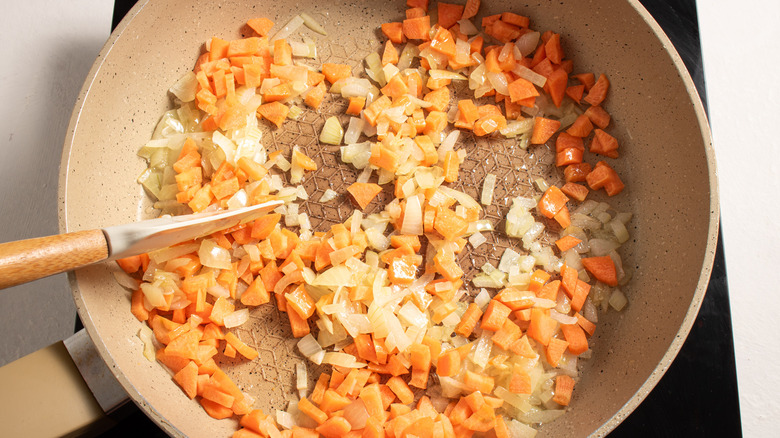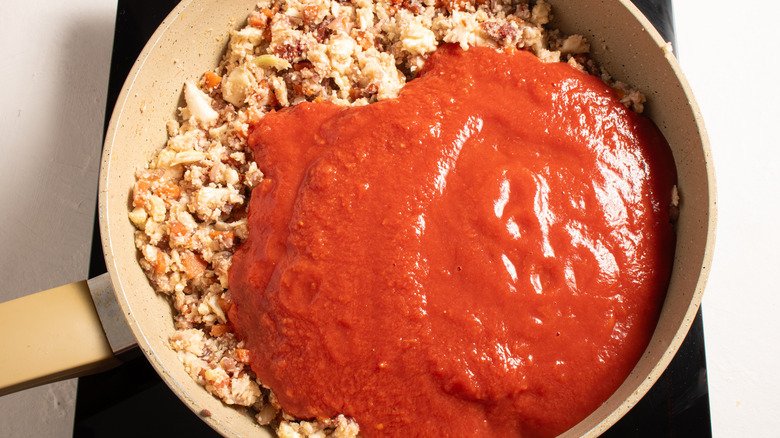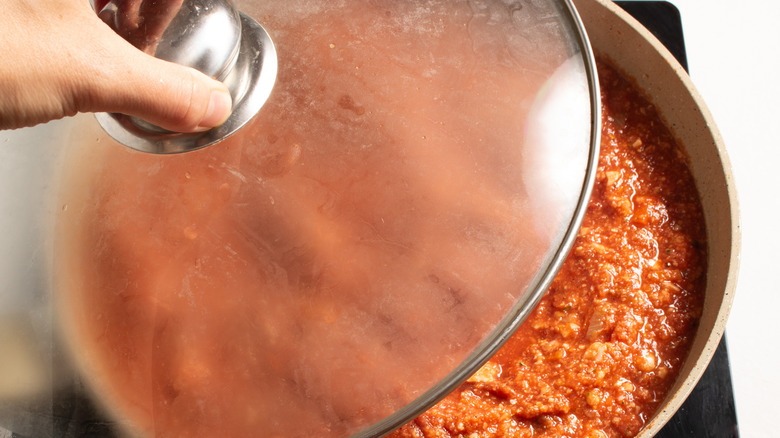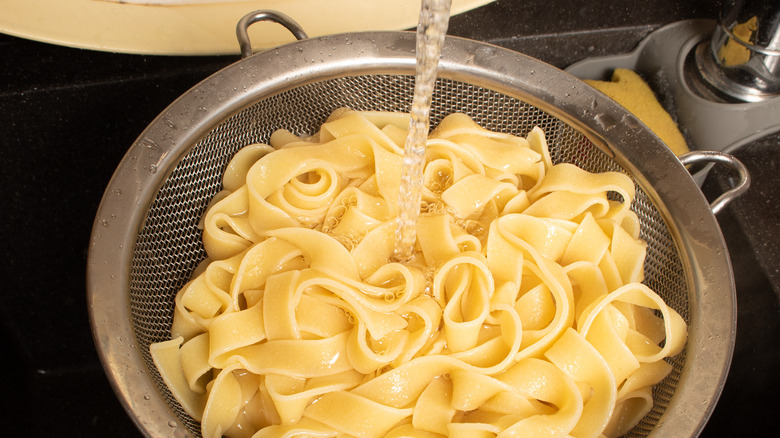Vegetarian Cauliflower Bolognese Recipe
If you've made the transition to a vegetarian diet or are always on the lookout for new ways to add more plant-based meals to your weekly plan, chances are that pasta is on the menu. Pasta is endlessly customizable and can be served with a wide range of sauces to include whichever ingredients you enjoy and have on hand. Mashed recipe developer Milena Manolova shares this vegetarian cauliflower bolognese recipe, which she describes as "a delicious and healthy alternative to traditional meat bolognese."
If you love the taste and texture of meat-based bolognese, you might enjoy this version even more. "The cauliflower adds a satisfying meatiness that makes this dish a great alternative," Manolova explains and adds, "I like how light it is, even though it's made with pasta, it doesn't feel heavy." Of course, there's more than just cauliflower in this savory dish. "The combination of herbs, sun-dried tomatoes, and other seasonings creates a delicious and complex flavor profile," she notes. Manolova recommends serving this flavorful and satisfying dish with garlic bread to soak up any extra sauce or with a refreshing green side salad. And if you really want to hone in on the veggies, "Zucchini noodles, instead of pasta, are also a great option," she says.
Gather ingredients for this vegetarian cauliflower bolognese
For this recipe, you'll need vegetable oil, diced yellow onion, diced carrots, minced garlic cloves, diced sun-dried tomatoes in oil, red wine, raw cauliflower rice, and tomato sauce. To season the dish, get salt, black pepper, sugar, dry oregano, paprika, and chili flakes. Finally, you'll need tagliatelle pasta, chopped fresh parsley, grated parmesan cheese, and fresh basil to serve.
If you want to infuse this dish with a boost of protein, Manolova has several ideas, starting with beans and legumes. She suggests lentils, noting that they give the sauce a great texture, whereas "black beans, add a rich and earthy flavor to the sauce." Meanwhile, soy protein like crumbled tofu and tempeh "can mimic the texture of ground meat." Finally, she recommends trying quinoa, which also infuses the dish with nuttiness and a complex texture.
Step 1: Saute the onions
In a saute pan, add the oil and onion, and cook over medium heat for about 5 minutes, or until the onion is soft.
Step 2: Add the carrots
Add the carrots and cook for 5 more minutes.
Step 3: Add garlic and sun-dried tomatoes
Stir in the minced garlic and then add the sun-dried tomatoes. Cook for 1-2 minutes.
Step 4: Add red wine to the pan
Pour in the red wine and cook the sauce for 3-4 more minutes.
Step 5: Stir in the cauliflower
Mix in the cauliflower rice.
Step 6: Add the sauce
Add the tomato sauce.
Step 7: Add seasonings
Add the salt, black pepper, sugar, dry oregano, paprika, and chili flakes.
Step 8: Cover and cook the sauce
Stir and let the sauce cook on low-medium heat for about 10 minutes with the lid on.
Step 9: Cook the pasta
Meanwhile, cook the pasta in salted water according to the package. It should be slightly undercooked, as it will be cooked more with the sauce.
Step 10: Rinse the pasta
Rinse the pasta with cold water to stop the cooking process.
Step 11: Add the parsley to the sauce
Add the parsley to the sauce and mix it through.
Step 12: Toss the pasta with the sauce
Add the pasta to the sauce. Cook for about 2 minutes, mixing the pasta and the sauce.
Step 14: Garnish and serve the cauliflower bolognese
To serve, sprinkle some parmesan cheese on top and garnish with some fresh basil if you desire.
Why do we cook pasta al dente?
Manolova recommends draining the pasta when it's still al dente, or has some bite to it. The term means "to the tooth" in Italian, and it describes pasta that is cooked till it's still a bit firm and slightly under-cooked in the middle. As she explains, "It has a bit of resistance when you bite into it, which many people find more enjoyable than overcooked, mushy pasta." Boiling the pasta for this slightly shorter duration has many benefits for the final taste and texture of a pasta dish. Since you're tossing the pasta into the hot sauce before serving it will cook more in the process, which will allow it to absorb some of the sauce and means there's less risk of overcooking it.
"Pasta cooked al dente holds up better in sauces and can absorb flavors more effectively than overcooked pasta," Manolova explains and describes, "It has a firm, slightly chewy texture that provides a satisfying mouthfeel." So be sure to cook the pasta for a minute or two less than the time noted on the box before adding it to the sauce. It should have some substance but not be crunchy, and the center of the pasta should not be too pale, which would indicate that it is undercooked. It also helps to rinse the pasta in cold water to halt the cooking process, as in this recipe.
What is cauliflower rice and how do I cook it?
Cauliflower rice provides a fun and creative way to eat more veggies. On a nutritional level, Manolova explains, "Cauliflower rice is a low-carb, gluten-free, and nutrient-dense alternative to traditional rice or meat (as in this recipe)." It's not difficult to make, but if you're in a hurry you can buy it in the refrigerated produce section of some grocery stores. If you're going to make it at home, "Cauliflower rice is made by grating the cauliflower with a box grater or pulsing it in a food processor until it reaches a rice-like consistency." Manolova instructs. You want to stop short of pureeing the vegetable so that it still has some body and doesn't turn to mush when it hits the sauce.
Cauliflower rice is a great addition to sauces, as the small pieces will quickly cook in the hot liquid and still retain some of their pleasing texture. However, you can also prepare it by itself, as Manolova suggests. "You can simply cook it in a skillet with a bit of oil or butter until it's tender but still slightly crisp. You could also steam it for a few seconds and season it with your choice of herbs and spices." She warns, "Just be careful not to steam it for too long or it will become mushy."

- 2 tablespoons vegetable oil
- ¾ cup diced yellow onion
- ⅔ cup diced carrots
- 4 cloves garlic, minced
- ⅓ cup diced sun-dried tomatoes in oil
- ¼ cup red wine
- 3 cups raw cauliflower rice
- 28 ounces tomato sauce
- ¾ teaspoon salt
- ¼ teaspoon black pepper
- 1 tablespoon sugar
- 1 teaspoon dry oregano
- 1 teaspoon paprika
- 1 teaspoon chili flakes
- ½ pound tagliatelle
- ¼ cup chopped fresh parsley
- ½ cup grated parmesan cheese
- Fresh basil, to serve
- In a saute pan, add the oil and onion, and cook over medium heat for about 5 minutes, or until the onion is soft.
- Add the carrots and cook for 5 more minutes.
- Stir in the minced garlic and then add the sun-dried tomatoes. Cook for 1-2 minutes.
- Pour in the red wine and cook the sauce for 3-4 more minutes.
- Mix in the cauliflower rice.
- Add the tomato sauce.
- Add the salt, black pepper, sugar, dry oregano, paprika, and chili flakes.
- Stir and let the sauce cook on low-medium heat for about 10 minutes with the lid on.
- Meanwhile, cook the pasta in salted water according to the package. It should be slightly undercooked, as it will be cooked more with the sauce.
- Rinse the pasta with cold water to stop the cooking process.
- Add the parsley to the sauce and mix it through.
- Add the pasta to the sauce. Cook for about 2 minutes, mixing the pasta and the sauce.
- Serve right the way.
- To serve, sprinkle some parmesan cheese on top and garnish with some fresh basil if you desire.
| Calories per Serving | 486 |
| Total Fat | 14.8 g |
| Saturated Fat | 3.8 g |
| Trans Fat | 0.1 g |
| Cholesterol | 12.6 mg |
| Total Carbohydrates | 69.8 g |
| Dietary Fiber | 8.6 g |
| Total Sugars | 15.8 g |
| Sodium | 1,230.9 mg |
| Protein | 19.4 g |

















